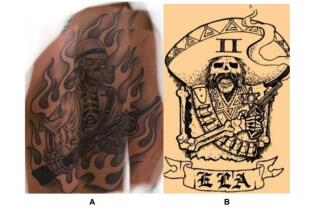Simi Police Will Review Body Armor Policy : Law enforcement: Vests are expected to stay optional in wake of Clark’s death. Most officers wear them, despite inconvenience.
- Share via
When Simi Valley Police Officer Michael Clark was gunned down a week ago, he was not wearing an armored vest. He was not required to wear one.
Although police officials say a vest probably would not have saved Clark’s life, the department will review its voluntary armor policy as part of the probe into his death. Few expect the policy to change. Ventura Assistant Police Chief Randy Adams, who will take over the Simi department next month, believes officers need the freedom to use their own discretion.
“Personally, I wouldn’t respond to a call for service without a vest, but that doesn’t mean I would make it mandatory for everyone,” Adams said.
All county police officers are provided with armored vests, but only the Oxnard Police Department requires officers to wear them. It’s optional everywhere else in the county, even for federal agents--against the recommendations of state and national law enforcement experts.
“Armored vests are crucial,” said Mario Rodriguez, a consultant with Peace Officers Standards and Training in Sacramento, which establishes training standards for California’s police academies.
“An agency has the responsibility to protect its officers, and mandating body armor accomplishes that. It’s that simple.”
The president of the national Fraternal Order of Police also recommends requiring body armor. The organization runs an educational program that encourages officers to wear vests.
“Departments must be assertive and develop policies dictating when and where vests must be worn,” said Gil Gallegos, president of the FOP, based in Nashville, Tenn.
“There are times when officers absolutely need to wear a vest. They only get one chance.”
That’s how the Oxnard police see it. Vests have been a requirement there for more than 15 years, unless there is a medical reason that an officer cannot wear one.
Oxnard is in the minority of police forces statewide. According to the U.S. Department of Justice, only 27 out of 76 California law enforcement agencies with more than 100 officers required cops on patrol to use the vests in 1990, the most recent year for which statistics are available.
“It’s a tool provided for our safety,” Oxnard Police Chief Harold Hurtt said. “It makes good sense to use it.”
Hurtt’s opinion is echoed by many in his department.
“It doesn’t make me bulletproof, but it could save my life and it gives me peace of mind,” Officer Mike Williamson said.
Fellow officer Chris Orsini agreed. “The vest is a must,” Orsini said. “You never know what you’ll encounter out there. Sometimes I wish they made armor to cover the rest of our bodies.”
*
Armored vests are designed to provide critical protection to an officer’s chest area, both front and back. Frequently called bulletproof vests, they actually aren’t. Depending on their strength, which varies, vests generally stop smaller-caliber handguns but not high-caliber weapons fired at close range or high-powered rifles fired from varying distances. Vests must fit around a complex, moving object--an officer--so there are gaps in protection. Bullets can make their way to the heart or a large artery through areas such as the neck, waist and underarm, which is apparently what happened to Clark. Bullets are unpredictable. They ricochet, angle up and down--and kill, vest or no vest.
But body armor provides a reasonable amount of protection, and its use is on the rise, said Rodriguez of the Sacramento training organization.
“In the 1980s, only about 50% of officers wore vests,” Rodriguez said. “That number has increased to about 80%.”
Part of the reason for the increase is that most vests weigh only about three or four pounds--less than the Ventura County telephone book.
*
As new technology develops, they become less bulky, too. But they are still about as much fun to wear as a steel cummerbund or a life vest. They don’t breathe, they are hot and they can restrict movement, which is often why Ventura County law enforcement agencies don’t insist they be worn.
“Vests are extremely uncomfortable, especially in the hot weather,” said sheriff’s spokesman Bruce Hansen. “I seldom wore a vest while I was on patrol. For me, personal comfort took precedence over worrying about getting shot.”
Add a dash of independence for older cops--they worked for years without armor--and you have a recipe for optional wear.
“I think officers are mature enough to make the decision for themselves,” Hansen said.
Acting Simi Valley Police Chief Dick Wright also places personal responsibility above mandatory body armor.
“Officers should be allowed a certain amount of discretion,” Wright said. “They understand the risks.”
But discretion leads to apathy, which is why seat belts and motorcycle helmets are mandated, Rodriguez said. “If you have a choice, you come up with reasons and excuses not to wear armor.”
Still, the great majority of police officers, Simi Valley included, say they wear vests except when it is not practical, as during undercover operations.
“I can only think of two or three patrol officers that choose not to wear vests,” Ventura Detective Brent Johnson said.
“I haven’t seen a deputy without one since I don’t know when,” said east county Cmdr. Kathy Kemp. “We strongly encourage they are worn. I always wore my vest.”
For Oxnard’s Orsini, the benefits outweigh the inconveniences.
“You get used to it,” Orsini said. “After awhile, it doesn’t slow you down and you forget it’s even there.”
More to Read
Sign up for Essential California
The most important California stories and recommendations in your inbox every morning.
You may occasionally receive promotional content from the Los Angeles Times.










